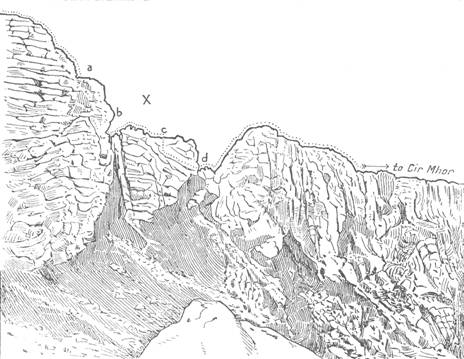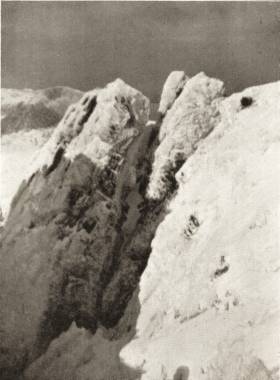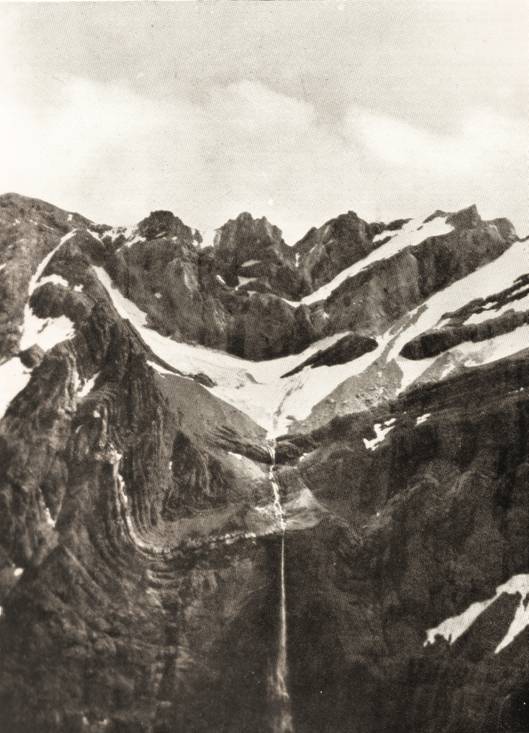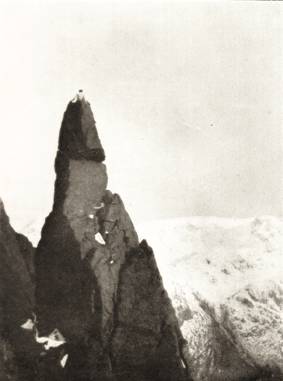Members’ Holidays In 1913
C. E. Benson. spent the first fortnight of September in Arran. With regard to the accompanying diagram of the mauvais pas on A’Chir (which is reproduced by kind permission from the S.M.C. Journal, vol. X., p. 103), he notes that the descent at b is made on the far side of the buttress, in the direction of Glen Iorsa, by some shallow and very rotten grooves. It seems to him that the mauvais pas is placed too near the end of the ridge and should commence below the point marked X. It consists of a short descent of the face by splendid holds to a grass ledge, which leads easily down to a little chimney. The only difficulty experienced in descending this is keeping the buttons on one’s waistcoat. In fact, the A’Chir ridge is, except at the descent b indicated above, magnificently sound, in happy contrast to much of the Arran rook, and exceedingly rough withal. Those who wish to escape, in appearance at any rate, from the ranks of Sir Claud Schuster’s “ninety and nine just persons whose knickerbockers are still unriven,” are recommended to take the A’Chir ridge in a hurry. The end of the ridge beyond the mauvais pas does not go. The corrie between A’Chir and Cir Mhur, unnamed on the maps, is Coire Buidhe. Ramblers staying at Brodick, who wish to take the ridge walk over Ben Nuis, Ben Tarsuinn, &c., and approach by the usual route the “left” bank of the Garbh Allt are advised that, in spate, the Garbh Allt may be impassable. After very wet weather it is better to follow the “string” road, from Brodick to Blackwater Foot as far as the skyline, and then turn off to one’s right. The Rosa Pinnacle does not go from the Glen Rosa side. There is, however, an easy way up a little below the summit of Cir Mhor. Those proceeding from the Peaks of the Castles, over the Carlin’s Leap, itself a pleasing little climb, are recommended to keep strictly to the ridge line, especially in bad weather. The direct descent from Cioch na h’Oighe to Sannox does not go. The descent from the ridge line between Mullach Buidhe and North Goatfell is unadulterated beastliness. It lies between Cyclopean walls and great “boiler plates,” often as rotten as pie-crust, by intricacies of disintegrated granite and treacherous turf. Its disgusting peculiarities are markedly accentuated by heavy wind and rain. It is not a walk; it is not a climb; it is a “demnition grind.”
Before the approach of the “Arran Conference” Benson fled to the Lakes. He would commend to Ramblers staying in Borrowdale, who can spare a few hours away from the rocks, the walk over the King’s How (formerly Brand and Grange Fells), purchased by the National Trust in 1910 and opened by H.R.H. The Princess Louise as a memorial to His Late Majesty King Edward VII. The walk is, perhaps, preferably taken from south to north, on account of the wonderful surprise view of Derwentwater. He had some pleasing climbing on Gable Crag and elsewhere. The rocks were in first-class condition.
C. R. Wingfieldary 12th to 18th. – At Arosa, S.C.G.B. Meet; 18th, Arosa to Davos, on ski; 20th, Parsen Furka to Kublis, very fine run – about 5,000 ft.; 21st, jumped 16 metres; 25th to February 1st, at St. Moritz, some easy tours, having hurt arm jumping; January 31st, Muraigl Glacier fine run, nearly 5,000 ft., half done with one broken ski.
March 4th, – Pricked High Sheriff of Shropshire; 8th March, elected County Councillor.
Whitsun. – At Gaping Ghyll.
July 12th and 13th. – Climbing, near Bala, with Mr. Botterill.
August 9th to 30th, – Yachting on “Gwynfa.”
September 13th. – Shooting ptarmigan in a snowstorm on Schiehallion, 3,500 ft; September 15th to 22nd, shooting and fishing at Stornoway.
November 10th. – Elected Mayor of Shrewsbury.
A. CHARLESWORTH:- At Easter, with Mr. Frankland:- Gimmer Crags (A and B routes), Kern Knotts Crack, Eagle’s Nest Aréte, Abbey Buttress.
August, 1912, Pyrenees:- Ax les Thermes is not much of a centre for climbing, but abounds in interest for the geologist, the glaciated rocks in the neighbourhood reminding one of the Grimsel, in Switzerland. Andorra, too, is within fairly easy distance.
Luchon is an excellent centre for excursions. We visited the Port de Venasque, from which a fine View of the Maladetta group was obtained. The snow views of the Pyrenees are disappointing when compared with those of Switzerland, but the richly wooded valleys somewhat compensate for this. Indeed, I thought the valleys were more beautiful than those of Switzerland. The desolate valleys on the Spanish side were in striking contrast to those on the French.
Excursions were made to the Cirque d’Oo, a magnificent cirque containing a true “rock-basin,” of great interest to the geologist. The Rue d’Enfer, a magnificent gorge, at a height of about 6,000 ft., was also visited.
Gavarnie, however, was the most striking centre. The famous cirque, consisting of highly-contorted cretaceous rocks and rising in terraces to a height of 2,500 ft. from the foot, never lacked interest. During the day the place is alive with visitors from Lourdes and other places down the Valley, but at night Gavarnie is deserted. The climber need not be deterred from staying there, as he will see no crowd if he is away during the day.
The climbs within easy reach of Gavarnie are numerous. We spent much time about the Brèche de Roland and found the rocks very rotten and dangerous.
The rest of the holiday was spent at Lourdes, Pau and Biarritz. Variety is assured by a Pyrenean holiday, as, if the tourist is tired of climbing and geology, he can “sandwich” amongst it such trivialities as the “Battle of Flowers” at Luchon, the pathos of pilgrimage at Lourdes and savagery of Spanish bullfights at Bayonne.
The Editor and J. J. Brigg (with Mr. Eric Greenwood) spent the last three weeks of July in North Tirol:-
July 11th to August 1st.- By the Arlberg Tunnel to Oetzthal Station; drive and walk by Solden to Vent; Taufkaarjoch to Braunschweiger Hut and return to Vent by Solden; two days indoors; Hochjoch Hospiz; Ramol Alp Sanmoar Hut, climbed Similaun and down to Kärthaus; drive to Bozen and train to Sterzing; Sonklarhof in Ridnaunthal; Grohmann Hütte, bad weather; back to Sterzing; St. Jakob, thunderstorm ; Pfitschjoch to Breitlahner; Berliner Hütte and climbed Schwarzenstein; Ginzling, Mayrhofen, Innsbruck.
Anyone reading between the lines will see that as a climbing expedition our trip was not brilliant. Both Similaun and Schwarzenstein are plain snow mountains. The latter we climbed, in a thick mist, with many Germans. The former is a happy memory of sun and snow and pleasant company and will always have a sentimental interest to readers of Von Hillern’s “Vulture Maiden” as the place of exile of poor, headstrong Wally. We sat for two solid days in the little inn at Vent, waiting for the rain to cease. We expanded Baedeker’s time (Vent to Braunschweiger Hütte) from five hours to nine, tramping through deep, soft snow on two breakfast rolls apiece. We slept at Kärthaus, a ramshackle old village built in and round a deserted Carthusian monastery, where each monk lived solitary in a small, two-roomed house opening from the cloister, as you may see at Mount Grace, near Northallerton. We loitered in the arcades of Sterzing and Bozen, with their piles of ripe fruit. We spent an idle afternoon in the Grohmann Hütte and fled to the valley, next day, before a blizzard. We explored the garret of the Stern Inn at Mareit and carried off a spinning wheel and other old-world gear. And, speaking generally, we found in these Tirol valleys a field for the walker, who may climb higher peaks or not as he pleases, with good paths (indicated by splotches of green and red paint on stones and trees), inns and “bewirthschaftet” mountain huts at convenient intervals and a ready courtesy from all we met, native and visitor. “Grüss Gott” is the greeting one meets everywhere in Tirol.



